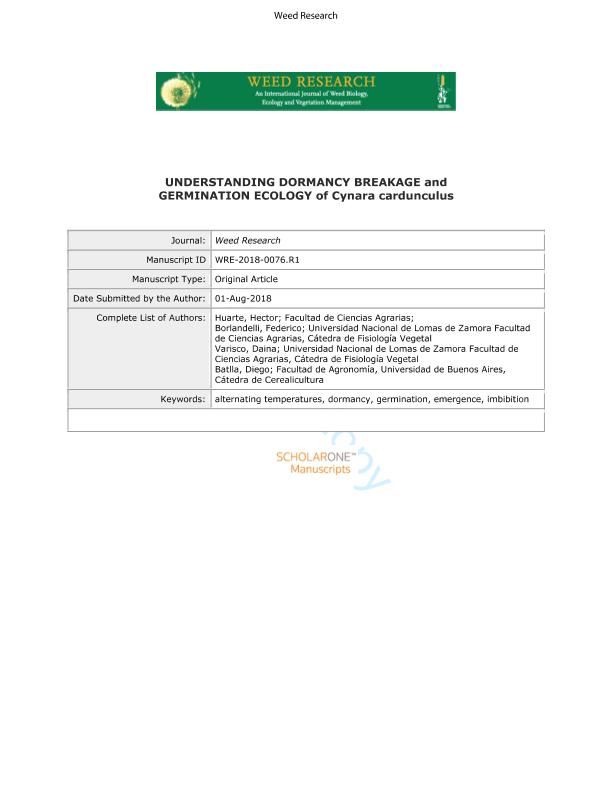Mostrar el registro sencillo del ítem
dc.contributor.author
Huarte, Hector Roberto

dc.contributor.author
Bolandelli, Federico
dc.contributor.author
Varisco, Daiana Ayelen

dc.contributor.author
Batlla, Diego

dc.date.available
2019-11-13T19:20:00Z
dc.date.issued
2018-12
dc.identifier.citation
Huarte, Hector Roberto; Bolandelli, Federico; Varisco, Daiana Ayelen; Batlla, Diego; Understanding dormancy breakage and germination ecology of Cynara cardunculus (Asteraceae); Wiley Blackwell Publishing, Inc; Weed Research; 58; 6; 12-2018; 450-462
dc.identifier.issn
0043-1737
dc.identifier.uri
http://hdl.handle.net/11336/88763
dc.description.abstract
Cynara cardunculus is a troublesome weed in temperate grazing lands. Cynara cardunculus achenes are usually dormant at dispersal and require alternating temperatures to terminate dormancy and germinate. Laboratory and glasshouse experiments were conducted to determine (i) the treatments able to terminate dormancy and (ii) the effect of environmental factors and agronomic practices on germination and emergence of non-dormant (dry after-ripened) achenes. Scarification, hydrogen peroxide and sodium hypochlorite promoted germination of dormant achenes. Dry after-ripening and cold stratification were tested in two different populations. Dormancy of both populations was released from dormancy by dry after-ripening. In contrast, cold stratification allowed dormancy release in just one of the populations, while the other was induced into secondary dormancy. Germination of non-dormant (dry after-ripened) achenes was maximum in a range of temperatures from 10 to 20°C and was inhibited at higher temperatures. Reduction of osmotic potential below −0.6 MPa led to a decrease in final germination. These results explain synchronic emergence of C. cardunculus seedlings in autumn after dormancy release during summer. Maximum seedling emergence was close to 60% at soil depths of 1 cm and only decreased as depth increased over 6 cm. In contrast, seedling emergence was not reduced by the presence of cover residues, while a flooding duration of 21 days was required to suppress emergence significantly. These results suggest that the deep burial of achenes and agronomic practices that take advantage of synchronic emergence of achenes could be useful tools leading to better long-term management of C. cardunculus.
dc.format
application/pdf
dc.language.iso
eng
dc.publisher
Wiley Blackwell Publishing, Inc

dc.rights
info:eu-repo/semantics/openAccess
dc.rights.uri
https://creativecommons.org/licenses/by-nc-sa/2.5/ar/
dc.subject
ALTERNATING TEMPERATURES
dc.subject
DORMANCY
dc.subject
EMERGENCE
dc.subject
GERMINATION
dc.subject
IMBIBITION
dc.subject
WILD ARTICHOKE
dc.subject.classification
Agricultura

dc.subject.classification
Agricultura, Silvicultura y Pesca

dc.subject.classification
CIENCIAS AGRÍCOLAS

dc.title
Understanding dormancy breakage and germination ecology of Cynara cardunculus (Asteraceae)
dc.type
info:eu-repo/semantics/article
dc.type
info:ar-repo/semantics/artículo
dc.type
info:eu-repo/semantics/publishedVersion
dc.date.updated
2019-10-28T18:17:33Z
dc.journal.volume
58
dc.journal.number
6
dc.journal.pagination
450-462
dc.journal.pais
Reino Unido

dc.journal.ciudad
Londres
dc.description.fil
Fil: Huarte, Hector Roberto. Universidad Nacional de Lomas de Zamora; Argentina. Consejo Nacional de Investigaciones Científicas y Técnicas; Argentina
dc.description.fil
Fil: Bolandelli, Federico. Universidad Nacional de Lomas de Zamora; Argentina
dc.description.fil
Fil: Varisco, Daiana Ayelen. Universidad Nacional de Lomas de Zamora; Argentina
dc.description.fil
Fil: Batlla, Diego. Consejo Nacional de Investigaciones Científicas y Técnicas. Oficina de Coordinación Administrativa Parque Centenario. Instituto de Investigaciones Fisiológicas y Ecológicas Vinculadas a la Agricultura. Universidad de Buenos Aires. Facultad de Agronomía. Instituto de Investigaciones Fisiológicas y Ecológicas Vinculadas a la Agricultura; Argentina
dc.journal.title
Weed Research

dc.relation.alternativeid
info:eu-repo/semantics/altIdentifier/doi/https://doi.org/10.1111/wre.12331
dc.relation.alternativeid
info:eu-repo/semantics/altIdentifier/url/https://onlinelibrary.wiley.com/doi/abs/10.1111/wre.12331
Archivos asociados
